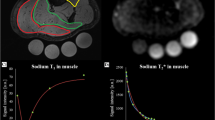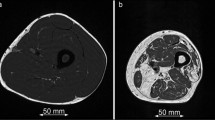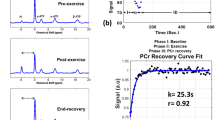Abstract
Objective
To evaluate healthy skeletal muscle pre- and post-exercise via 7 T 23Na MRI and muscle proton T2 mapping, and to evaluate diabetic muscle pre- and post-exercise via 7 T 23Na MRI.
Methods
The calves of seven healthy subjects underwent imaging pre- and post-exercise via 7 T 23Na MRI (3D fast low angle shot, TR/TE = 80 ms/0.160 ms, 4 mm × 4 mm × 4 mm) and 1 week later by 1H MRI (multiple spin-echo sequence, TR/TE = 3,000 ms/15–90 ms). Four type 2 diabetics also participated in the 23Na MRI protocol. Pre- and post-exercise sodium signal intensity (SI) and proton T2 relaxation values were measured/calculated for soleus (S), gastrocnemius (G), and a control, tibialis anterior (TA). Two-tailed t tests were performed.
Results
In S/G in healthy subjects post-exercise, sodium SI increased 8–13% (p < 0.03), then decreased (t 1/2 = 22 min), and 1H T2 values increased 12–17% (p < 0.03), then decreased (t 1/2 = 12–15 min). In TA, no significant changes in sodium SI or 1H T2 values were seen (−2.4 to 1%, p > 0.17). In S/G in diabetics, sodium SI increased 10–11% (p < 0.04), then decreased (t 1/2 = 27–37 min) without significant change in the TA SI (−3.6%, p = 0.066).
Conclusion
It is feasible to evaluate skeletal muscle via 3D 23Na MRI at 7 T. Post-exercise muscle 1H T2 values return to baseline more rapidly than sodium SI. Diabetics may demonstrate delayed muscle sodium SI recovery compared with healthy subjects.





Similar content being viewed by others
References
Fleckenstein JL, Canby RC, Parkey RW, Preshock RM (1988) Acute effects of exercise on MR imaging of skeletal muscle in normal volunteers. AJR Am J Roentgenol 151:231–237
Fleckenstein JL, Bertocci LA, Nunnally RL, Parkey RW, Peshock RM (1989) Exercise-enhanced MR imaging of variation in forearm muscle anatomy and use: importance in MR spectroscopy. Am J Roentgenol 153:693–698
Patten C, Meyer RA, Fleckenstein JL (2003) T2 mapping of muscle. Semin Musculoskelet Radiol 7:297–305
Meyer RA, Prior BM (2000) Functional magnetic resonance imaging of muscle. Exerc Sport Sci Rev 28:89–92
Damon BM, Gregory CD, Hall KL et al (2002) Intracellular acidification and volume increases explain R 2 decreases in exercising muscle. Magn Reson Med 47:14–23
Saab G, Thompson RT, Marsh GD (2000) Effects of exercise on muscle transverse relaxation determined by MR imaging and in vivo relaxometry. J Appl Physiol 88:226–233
Ploutz-Snyder LL, Nyren S, Cooper TG, Potchen EJ, Meyer RA (1997) Different effects of exercise and edema on T2 relaxation in skeletal muscle. Magn Reson Med 37:676–82
Fleckenstein JL, Haller RG, Lewis SF et al (1991) Absence of MRI enhancement of skeletal muscle in McArdle’s disease. J Appl Physiol 71:961–969
Yoshioka H, Anno I, Kuramoto K et al (1995) Acute effects of exercise on muscle MRI in peripheral arterial occlusive disease. Magn Reson Imaging 13:651–659
Clausen T (2003) Na+–K+ pump regulation and skeletal muscle contractility. Physiol Rev 83:1269–1324
Clausen T (2005) Na+–K+ pump stimulation improves contractility in damaged muscle fibers. Ann NY Acad Sci 1066:286–294
McKenna MJ, Bangsbo J, Renaud JM (2008) Muscle K+, Na+, and Cl- disturbances and Na+–K+ pump inactivation: implications for fatigue. J Appl Physiol 104:288–295
Constantinides CD, Gillen JS, Boada FE, Pomper MG, Bottomley PA (2000) Human skeletal muscle: sodium MR imaging and quantification—potential applications in disease and exercise. Radiology 216:559–568
Bansal N, Szczepaniak L, Ternullo D, Fleckenstein JL, Malloy CR (2000) Effect of exercise on 23Na MRI and relaxation characteristics of human calf muscle. J Magn Reson Imaging 11:532–538
Weber MA, Nielles-Vallespin S, Huttner H et al (2006) Evaluation of patients with paramyotonia at 23Na MR imaging during cold-induced weakness. Radiology 240:489–500
Nielles-Vallespin S, Weber MA, Bock M, Bongers A, Speier P, Combs SE, Wohrle J, Lehmann-Horn F, Essig M, Schad LR (2007) 3D radial projection technique with ultrashort echo times for sodium MRI: clinical applications in human brain and skeletal muscle. Magn Reson Med 57:74–81
Stollberger R, Wach P, McKinnon G, Justich E, Ebner F (1988) RF-field mapping in vivo. In: Proceedings of the 7th annual meeting of ISMRM, San Francisco, CA, p 106
Jerecic R, Bock M, Nielles-Vallespin S, Wacker C, Bauer W, Schad LR (2004) ECG-gated 23Na-MRI of the human heart using a 3D-radial projection technique with ultra-short echo times. MAGMA 16:297–302
Wang L, Wu Y, Chang G et al (2009) Rapid isotropic 3D-sodium MRI of the knee joint at in vivo at 7T. J Magn Reson Imaging 30:606–614
Collins CM (2006) Radiofrequency field calculations for high field MRI. In: Robitaille PM, Berliner LJ (eds) Ultra high field magnetic resonance imaging. Springer, New York, NY, pp 209–248
Sjogaard G, Adams RP, Saltin B (1985) Water and ion shifts in skeletal muscle of humans with intense dynamic knee extension. Am J Physiol Regul Integr Comp Physiol 248:R190–R196
Fong CN, Atwood HL, Charlton MP (1986) Intracellular sodium activity at rest and after titanic stimulation in muscles of normal and dystrophic (dy2j/dy2j)C57B1/6J mice. Exp Neurol 93:359–368
Juel C (1986) Potassium and sodium shifts during in vitro isometric muscle contraction, and the time course of the ion-gradient recovery. Pflugers Arch 406:458–463
Magzoub M, Zhang H, Dix JA, Verkman AS (2009) Extracellular space volume measured by two-color pulsed dye infusion with microfiberoptic fluorescence photodetection. Biophys J 96:2382–90
McKenna MJ, Bangsbo J, Renaud JM (2008) Muscle K+, Na+, and Cl- disturbances and Na+–K+ pump inactivation: implications for fatigue. J Appl Physiol 104:288–295
Djurhuus MS, Vaag A, Klitgaard NAH (2001) Muscle sodium, potassium, and [3H]-ouabain binding in identical twins, discordant for type 2 diabetes. J Clin Endocrinol Metab 86:859–866
Kjeldsen K, Braendgaard H, Sidenius P et al (1987) Diabetes decreases Na+–K+ pump concentration in skeletal muscles, heart ventricular muscle, and peripheral nerves of rat. Diabetes 36:842–848
Sweeney G, Klip A (2001) Mechanisms and consequences of Na+–K+ pump regulation by insulin and leptin. Cell Mol Biol 47:363–372
Jelinek JS, Murphey MD, Aboulafia AJ, Dussault RG, Kaplan PA, Snearly WN (1999) Muscle infarction in patients with diabetes mellitus: MR imaging findings. Radiology 211:241–247
Ly JQ, Yi EK, Beall DP (2003) Diabetic muscle infarction. AJR Am J Roentgenol 181:1216
Acknowledgements
The authors would like to acknowledge support from the RSNA (RR0806) and NIAMS/NIH (R01-AR053133–01A2).
Author information
Authors and Affiliations
Corresponding author
Rights and permissions
About this article
Cite this article
Chang, G., Wang, L., Schweitzer, M.E. et al. 3D 23Na MRI of human skeletal muscle at 7 Tesla: initial experience. Eur Radiol 20, 2039–2046 (2010). https://doi.org/10.1007/s00330-010-1761-3
Received:
Revised:
Accepted:
Published:
Issue Date:
DOI: https://doi.org/10.1007/s00330-010-1761-3




